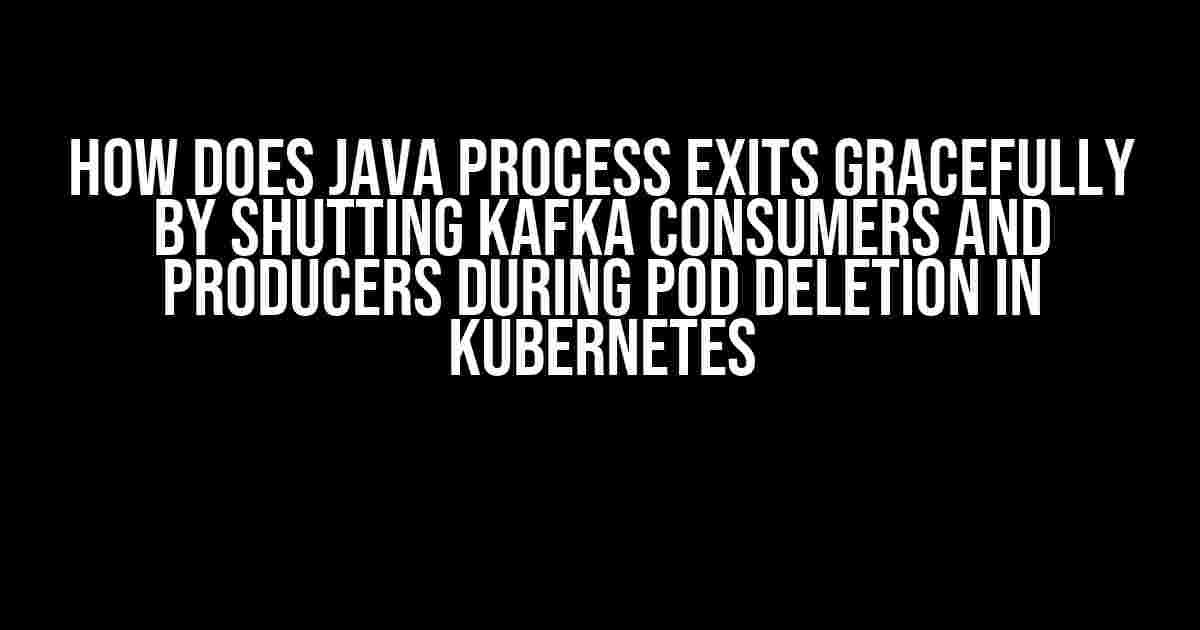Are you tired of dealing with the frustration of ungraceful shutdowns in your Java application during pod deletion in Kubernetes? Do you want to ensure that your Kafka consumers and producers exit smoothly, without data loss or corruption? Look no further! In this article, we’ll dive into the world of Java, Kafka, and Kubernetes to explore the magic of graceful shutdowns.
Why is Graceful Shutdown Important?
Before we dive into the technical aspects, let’s understand why graceful shutdowns are crucial in a distributed system like Kubernetes. Imagine a scenario where your Java application is consuming messages from a Kafka topic, and suddenly, the pod is deleted due to a rolling update or a scaling event. If your application doesn’t shut down gracefully, you risk:
- losing unprocessed messages in the Kafka topic
- causing data inconsistencies or corruption
- triggering unnecessary retries or retries loops
- affecting the overall system’s stability and performance
The Java Application Shutdown Hook
In Java, the shutdown hook is a mechanism that allows your application to execute custom code before the JVM exits. To shut down your Kafka consumers and producers gracefully, you’ll need to register a shutdown hook in your Java application.
Runtime.getRuntime().addShutdownHook(new Thread(() -> {
// Graceful shutdown logic goes here
});
Kafka Consumer Shut Down
Now that we have our shutdown hook in place, let’s focus on shutting down Kafka consumers. When a consumer is closed, it should:
- Commit any pending offsets to ensure that no messages are lost
- unsubscribe from the topic to release resources
- Close the consumer to free up connections and threads
public class KafkaConsumerShutdown {
private final KafkaConsumer<String, String> consumer;
public KafkaConsumerShutdown(KafkaConsumer<String, String> consumer) {
this.consumer = consumer;
}
public void shutdown() {
consumer.commitSync(); // commit pending offsets
consumer.unsubscribe(); // unsubscribe from topic
consumer.close(); // close consumer
}
}
Kafka Producer Shut Down
Shutting down Kafka producers is equally important to prevent message loss or data corruption. When a producer is closed, it should:
- Flush any buffered messages to ensure that no messages are lost
- Close the producer to free up connections and threads
public class KafkaProducerShutdown {
private final KafkaProducer<String, String> producer;
public KafkaProducerShutdown(KafkaProducer<String, String> producer) {
this.producer = producer;
}
public void shutdown() {
producer.flush(); // flush buffered messages
producer.close(); // close producer
}
}
Integrating Shutdown Hooks with Kafka
Now that we have our Kafka consumer and producer shutdown logic in place, let’s integrate them with our shutdown hook.
Runtime.getRuntime().addShutdownHook(new Thread(() -> {
kafkaConsumerShutdown.shutdown();
kafkaProducerShutdown.shutdown();
}));
Kubernetes Pod Deletion and Shutdown
In a Kubernetes environment, pod deletion can occur due to various reasons like rolling updates, scaling, or node failures. To ensure that our Java application exits gracefully during pod deletion, we need to:
- Implement a shutdown hook in our Java application
- Ensure that our Kafka consumers and producers are shut down gracefully
- Configure Kubernetes to send a SIGTERM signal to our Java application during pod deletion
Kubernetes sends a SIGTERM signal to the container when a pod is deleted. This signal is caught by the JVM, which then executes the shutdown hook.
Conclusion
In this article, we explored the importance of graceful shutdowns in a Kubernetes environment and demonstrated how to shutdown Kafka consumers and producers gracefully in a Java application. By implementing shutdown hooks and integrating them with Kafka, we can ensure that our application exits smoothly, without data loss or corruption, even during pod deletion. Remember, a well-designed shutdown mechanism is crucial for maintaining the stability and performance of your distributed system.
| Best Practices |
|---|
| Implement a shutdown hook in your Java application |
| Ensure that Kafka consumers and producers are shut down gracefully |
| Configure Kubernetes to send a SIGTERM signal during pod deletion |
| Test your shutdown mechanism thoroughly in a staging environment |
By following these best practices, you can ensure that your Java application exits gracefully, even during unexpected pod deletions in a Kubernetes environment.
Additional Resources
For more information on shutdown hooks, Kafka, and Kubernetes, check out the following resources:
- Java Shutdown Hooks: https://docs.oracle.com/javase/8/docs/api/java/lang/Runtime.html#addShutdownHook-java.lang.Thread-
- Kafka Consumer API: https://kafka.apache.org/20/javadoc/org/apache/kafka/clients/consumer/KafkaConsumer.html
- Kafka Producer API: https://kafka.apache.org/20/javadoc/org/apache/kafka/clients/producer/KafkaProducer.html
- Kubernetes Pod Deletion: https://kubernetes.io/docs/concepts/workloads/pods/pod-lifecycle/#pod-termination
Here are 5 Questions and Answers about “How Does Java process exits gracefully by shutting kafka consumers and producers during pod deletion in Kubernetes”:
Frequently Asked Question
Get the inside scoop on how Java processes exiting gracefully during pod deletion in Kubernetes!
What is the importance of graceful shutdown of Kafka consumers and producers in a Java application?
A graceful shutdown of Kafka consumers and producers is crucial to ensure that no messages are lost during the shutdown process. This is especially important in a Kubernetes environment, where pods can be terminated at any moment. By shutting down Kafka consumers and producers cleanly, the Java application can ensure that all messages are processed and committed before the pod is deleted, preventing data loss and corruption.
How does Java process exit gracefully during pod deletion in Kubernetes?
When a pod is deleted in Kubernetes, the Java process running inside the container receives a SIGTERM signal. The Java application can catch this signal and initiate a graceful shutdown of the Kafka consumers and producers. This is typically done by using a shutdown hook, which is a special thread that is executed when the Java process is terminated. The shutdown hook can close the Kafka connections, commit any pending messages, and wait for any in-flight messages to be processed before exiting.
What is the role of the shutdown hook in graceful shutdown of Kafka consumers and producers?
The shutdown hook is a critical component of the graceful shutdown process. When the Java process receives the SIGTERM signal, the shutdown hook is executed, which in turn calls the close method on the Kafka consumers and producers. This close method initiates the shutdown sequence, which includes committing any pending messages, closing the Kafka connections, and waiting for any in-flight messages to be processed. The shutdown hook ensures that the Kafka consumers and producers are shut down cleanly, preventing data loss and corruption.
How can I configure the Java application to handle the SIGTERM signal and initiate a graceful shutdown?
To configure the Java application to handle the SIGTERM signal, you can use the Runtime.addShutdownHook method to register a shutdown hook. The shutdown hook should call the close method on the Kafka consumers and producers, and also wait for any in-flight messages to be processed. Additionally, you can configure the Kafka clients to send a close signal to the Kafka brokers, which will trigger a clean shutdown of the consumers and producers.
What are some best practices for implementing a graceful shutdown of Kafka consumers and producers in a Java application?
Some best practices for implementing a graceful shutdown of Kafka consumers and producers include using a shutdown hook, configuring the Kafka clients to send a close signal to the Kafka brokers, and waiting for any in-flight messages to be processed before exiting. Additionally, it’s important to ensure that the Kafka consumers and producers are thread-safe, and that the shutdown hook is executed in a timely manner to prevent data loss and corruption. It’s also important to test the graceful shutdown process to ensure that it works as expected in a Kubernetes environment.


